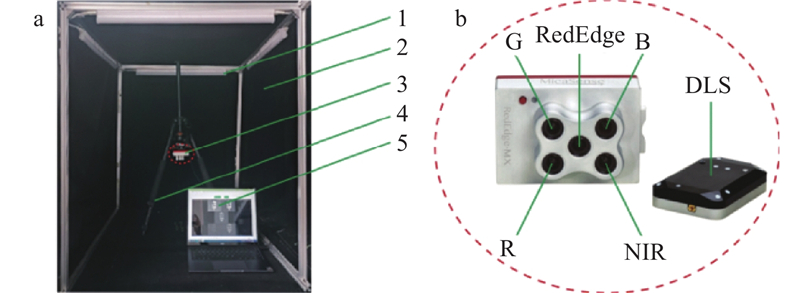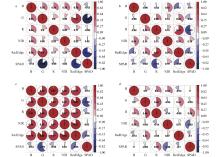

Scientia Silvae Sinicae ›› 2023, Vol. 59 ›› Issue (7): 78-88.doi: 10.11707/j.1001-7488.LYKX20220577
• Research papers • Previous Articles Next Articles
Xuexing Fan1( ),Huichun Zhang1,2,*(
),Huichun Zhang1,2,*( ),Yiping Zou3,4,Yuping Huang1,Liming Bian3
),Yiping Zou3,4,Yuping Huang1,Liming Bian3
Received:2022-08-28
Online:2023-07-25
Published:2023-09-08
Contact:
Huichun Zhang
E-mail:1362454289@qq.com;njzhanghc@hotmail.com
CLC Number:
Xuexing Fan,Huichun Zhang,Yiping Zou,Yuping Huang,Liming Bian. Inversion of Plant Chlorophyll Content Based on Multispectral Imaging and Machine Learning[J]. Scientia Silvae Sinicae, 2023, 59(7): 78-88.

Fig.2
A system for collecting plant phenotypic information at the proximal end of a multispectral camera a: Physical map of the near-end acquisition platform of the multispectral camera. 1: Stable light source;2: Stable dark box environment;3: RedEdge-MX multispectral camera;4: Gimbal;5: PC control terminal. b: RedEdge-MX multispectral camera assembly. B: blue band; G: green band; R: red band; NIR: near infrared band; RedEdge: red edge band; DLS module."


Fig.3
Correlation analysis between blade band reflectance and SPAD a:I. dabieshanensis mature leaves;b:I. dabieshanensis growing leaves;c:I. verticillata mature leaves;d:All test samples of Ilex leaves. B: the blue band (Blue);G: the green band (Green);R: the red band (Red);NIR: the near infrared band; RedEdge: the red edge band (RedEdge);SPAD: the relative content of chlorophyll."

Table 1
Fit performance of different inversion prediction models"
| 反演预测模型 Inversion prediction model | 反演预测模型评价指标 Inversion prediction model evaluation index | |||
| | | RMSE | MAE | |
| SVR | 0.24 | 0.23 | 0.160 | 0.119 |
| GS-SVR | 0.72 | 0.71 | 0.097 | 0.069 |
| GA-SVR | 0.84 | 0.83 | 0.073 | 0.050 |
| PSO-SVR | 0.91 | 0.87 | 0.066 | 0.044 |
| 边黎明, 张慧春. 表型技术在林木育种和精确林业上的应用. 林业科学, 2020, 56 (6): 113- 126. | |
| Bian L M, Zhang H C. Application of phenotyping technology in tree breeding and precision forestry. Scientia Silvae Sinicae, 2020, 56 (6): 113- 126. | |
|
曹德美, 张亚红, 成星奇, 等. 青杨不同种群叶片表型性状的遗传变异. 林业科学, 2021, 57 (8): 56- 67.
doi: 10.11707/j.1001-7488.20210806 |
|
|
Cao D M, Zhang Y H, Cheng X Q, et al. Genetic variation of leaf phenotypic traits in different populations of Populus cathayana . Scientia Silvae Sinicae, 2021, 57 (8): 56- 67.
doi: 10.11707/j.1001-7488.20210806 |
|
| 岑海燕, 姚洁妮, 翁海勇, 等. 叶绿素荧光技术在植物表型分析的研究进展. 光谱学与光谱分析, 2018, 38 (12): 3773- 3779. | |
| Cen H Y, Yao J N, Weng H Y, et al. Research progress of chlorophyll fluorescence technology in plant phenotyping. Spectroscopy and Spectral Analysis, 2018, 38 (12): 3773- 3779. | |
| 陈珠琳, 王雪峰. 基于植被指数及多光谱纹理特征的降香黄檀叶片全铁含量预测. 林业科学, 2020, 56 (2): 89- 98. | |
| Chen Z L, Wang X F. Prediction of total iron content in Dalbergia odorifera leaves based on vegetation index and multispectral texture features . Scientia Silvae Sinicae, 2020, 56 (2): 89- 98. | |
| 姜洪喆, 杨雪松, 李兴鹏, 等. 油茶果自然霉变程度的可见/近红外与中短波近红外光谱检测. 食品科学, 2022, 44 (4): 272- 277. | |
| Jiang H Z, Yang X S, Li X P, et al. Visible/near-infrared and short-wave near-infrared spectroscopy detection of natural mildew degree of Camellia oleifera fruit . Food Science, 2022, 44 (4): 272- 277. | |
| 李秋洁, 杨远明, 袁鹏成, 等. 基于饱和度分割的叶面积图像测量方法. 林业工程学报, 2021, 6 (4): 147- 152. | |
| Li Q J, Yang Y M, Yuan P C, et al. A leaf area image measurement method based on saturation segmentation. Journal of Forestry Engineering, 2021, 6 (4): 147- 152. | |
| 李修华, 卢显杰, 奚金阳, 等. 智能手机RGB图像检测植物叶片叶绿素含量的通用方法. 农业工程学报, 2021, 37 (22): 145- 151. | |
| Li X H, Lu X J, Xi J Y, et al. A general method for detecting chlorophyll content in plant leaves using smartphone RGB images. Chinese Journal of Agricultural Engineering, 2021, 37 (22): 145- 151. | |
| 李欣雨, 张 川, 闫浩芳, 等. 生物炭和灌水量对土壤保水性及温室番茄生理特性的影响. 排灌机械工程学报, 2022, 40 (3): 317- 324. | |
| Li X Y, Zhang C, Yan H F, et al. Effects of biochar and irrigation amount on soil water retention and physiological characteristics of greenhouse tomato. Journal of Drainage and Irrigation Machinery Engineering, 2022, 40 (3): 317- 324. | |
| 梁 栋, 杨勤英, 黄文江, 等. 基于小波变换与支持向量机回归的冬小麦叶面积指数估算. 红外与激光工程, 2015, 44 (1): 335- 340. | |
| Liang D, Yang Q Y, Huang W J, et al. Estimation of winter wheat leaf area index based on wavelet transform and support vector machine regression. Infrared and Laser Engineering, 2015, 44 (1): 335- 340. | |
| 刘 铮, 刘 英, 庄子龙, 等. 残差网络在工程竹材图像超分辨率中的应用. 林业机械与木工设备, 2022, 50 (5): 85- 90. | |
| Liu Z, Liu Y, Zhuang Z L, et al. Application of residual network in super-resolution of engineering bamboo images. Forestry Machinery & Woodworking Equipment, 2022, 50 (5): 85- 90. | |
| 马春艳, 王艺琳, 翟丽婷, 等. 冬小麦不同叶位叶片的叶绿素含量高光谱估算模型. 农业机械学报, 2022, 53 (6): 217- 225. | |
| Ma C Y, Wang Y L, Zhai L T, et al. A hyperspectral estimation model of chlorophyll content in leaves at different leaf positions of winter wheat. Transactions of the Chinese Society of Agricultural Machinery, 2022, 53 (6): 217- 225. | |
| 齐建东, 谭新新. 长白山红松阔叶林的净碳交换变化及基于时间卷积神经网络的模拟. 林业科学, 2022, 58 (2): 1- 12. | |
| Qi J D, Tan X X. Changes in net carbon exchange in the Pinus koraiensis broad-leaved forest in Changbai Mountain and simulation based on temporal convolutional neural network . Scientia Silvae Sinicae, 2022, 58 (2): 1- 12. | |
|
石吉勇, 李文亭, 郭志明, 等. 基于叶面叶绿素分布特征的黄瓜叶片氮钾元素亏缺诊断. 农业机械学报, 2019, 50 (8): 264- 269.
doi: 10.6041/j.issn.1000-1298.2019.08.029 |
|
|
Shi J Y, Li W T, Guo Z M, et al. Diagnosis of nitrogen and potassium deficiency in cucumber leaves based on chlorophyll distribution characteristics. Transactions of the Chinese Society of Agricultural Machinery, 2019, 50 (8): 264- 269.
doi: 10.6041/j.issn.1000-1298.2019.08.029 |
|
| 石永磊, 王志慧, 李世明, 等. 基于光学遥感的稀疏乔灌木地上部分生物量反演方法. 林业科学, 2022, 58 (2): 13- 22. | |
| Shi Y L, Wang Z H, Li S M, et al. Retrieval method of aboveground biomass of sparse trees and shrubs based on optical remote sensing. Scientia Silvae Sinicae, 2022, 58 (2): 13- 22. | |
| 唐彧哲, 红 梅, 郝嘉永, 等. 基于优化面积光谱指数的玉米叶片叶绿素值估测. 光谱学与光谱分析, 2022, 42 (3): 924- 932. | |
| Tang Y Z, Hong M, Hao J Y, et al. Estimation of chlorophyll value of maize leaves based on optimized area spectral index. Spectroscopy and Spectral Analysis, 2022, 42 (3): 924- 932. | |
| 王芳东, 严志雁, 赵小敏, 等. 油茶叶片叶绿素含量高光谱估测的偏最小二乘模型参数选择. 江西农业大学学报, 2022, 44 (1): 86- 96. | |
| Wang F D, Yan Z Y, Zhao X M, et al. Parameter selection of partial least squares model for hyperspectral estimation of chlorophyll content in Camellia oleifera leaves . Acta Agriculturae Universitis Jiangxiensis, 2022, 44 (1): 86- 96. | |
|
王好运, 吴 峰, 朱小坤, 等. 叶型对马尾松幼苗生长及叶绿素荧光特征的影响. 林业科学, 2019, 55 (3): 183- 192.
doi: 10.11707/j.1001-7488.20190321 |
|
|
Wang H Y, Wu F, Zhu X K, et al. Effects of leaf type on the growth and chlorophyll fluorescence characteristics of Pinus massoniana seedlings . Scientia Silvae Sinicae, 2019, 55 (3): 183- 192.
doi: 10.11707/j.1001-7488.20190321 |
|
| 王 璐, 李伟凯, 关海鸥, 等. 基于多维度光谱特征波长提取大豆冠层SPAD值估算模型. 江苏大学学报(自然科学版), 2020, 41 (3): 334- 338,372. | |
| Wang L, Li W k, Guan H O, et al. Estimation model for extracting SPAD value of soybean canopy based on multi-dimensional spectral characteristic wavelength. Journal of Jiangsu University(Natural Science Edition), 2020, 41 (3): 334- 338,372. | |
| 翁海勇, 黄俊昆, 万 亮, 等. 光谱重构油菜叶绿素含量快速检测方法及设备研制. 光谱学与光谱分析, 2021, 41 (1): 210- 215. | |
| Weng H Y, Huang J K, Wan L, et al. Development of a rapid detection method and equipment for chlorophyll content in rapeseed by spectral reconstruction. Spectroscopy and Spectral Analysis, 2021, 41 (1): 210- 215. | |
| 杨虹霞, 龙春瑞, 刘红明, 等. 不同柠檬品种叶片SPAD值、氮素含量与叶绿素含量相关性分析. 热带农业科学, 2019, 39 (8): 22- 28. | |
| Yang H X, Long C R, Liu H M, et al. Correlation analysis of SPAD value, nitrogen content and chlorophyll content in leaves of different lemon varieties. Chinese Journal of Tropical Agriculture, 2019, 39 (8): 22- 28. | |
| 由珈齐, 李明泽, 范文义, 等. 基于高光谱和激光雷达数据的林分类型识别. 林业科学, 2021, 57 (5): 119- 129. | |
| You J Q, Li M Z, Fan W Y, et al. Identification of stand types based on hyperspectral and LiDAR data. Scientia Silvae Sinicae, 2021, 57 (5): 119- 129. | |
| 赵京东, 宋彦涛, 何 畅, 等. 不同叶绿素测定方法的比较研究. 大连民族大学学报, 2020, 22 (5): 405- 410. | |
| Zhao J D, Song Y T, He C, et al. Comparative study of different chlorophyll determination methods. Journal of Dalian Nationalities University, 2020, 22 (5): 405- 410. | |
| 周小成, 郑 磊, 黄洪宇. 基于多特征优选的无人机可见光遥感林分类型分类. 林业科学, 2021, 57 (5): 24- 36. | |
| Zhou X C, Zheng L, Huang H Y. Classification of forest stand types based on UAV visible light remote sensing based on multi-feature optimization. Scientia Silvae Sinicae, 2021, 57 (5): 24- 36. | |
|
Clemente A A, Maciel G M, Siquierol A. et al. High-throughput phenotyping to detect anthocyanins, chlorophylls, and carotenoids in red lettuce germplasm. International Journal of Applied Earth Observation and Geoinformation, 2021, 103, 102533.
doi: 10.1016/j.jag.2021.102533 |
|
| Cuaran J L, Leon J. Crop monitoring using unmanned aerial vehicles: a review. Agricultural Reviews, 2021, 42 (2): 121- 132. | |
|
Fernández C I, Haddadi A, Leblon B, et al. Comparison between three registration methods in the case of non-georeferenced close range of multispectral images. Remote Sensing, 2021, 13 (3): 396.
doi: 10.3390/rs13030396 |
|
|
Jiang J L, Johansen K, Stanschewski C S, et al. Phenotyping a diversity panel of quinoa using UAV-retrieved leaf area index, SPAD-based chlorophyll and a random forest approach. Precision Agriculture, 2022, 23 (3): 961- 983.
doi: 10.1007/s11119-021-09870-3 |
|
|
Santana D C, Cotrim M F, Flores M S, et al. UAV-based multispectral sensor to measure variations in corn as a function of nitrogen topdressing. Remote Sensing Applications:Society and Environment, 2021, 23, 100534.
doi: 10.1016/j.rsase.2021.100534 |
|
|
Sarić R, Nguyen V D, Burge T, et al. Applications of hyperspectral imaging in plant phenotyping. Trends in Plant Science, 2022, 27 (3): 301- 315.
doi: 10.1016/j.tplants.2021.12.003 |
|
|
Somkuti P, O'dell C W, Crowell S, et al. Solar-induced chlorophyll fluorescence from the Geostationary Carbon Cycle Observatory (GeoCarb): an extensive simulation study. Remote Sensing of Environment, 2021, 263, 112565.
doi: 10.1016/j.rse.2021.112565 |
| [1] | Kunqi Yang,Huichun Zhang,Meng Zhang,Liming Bian. Effects of Water and Fertilizer Stress on Seedling Phenotypic Information Based on Time Series Images [J]. Scientia Silvae Sinicae, 2023, 59(5): 61-70. |
| [2] | Jiaqi Ding,Wenli Huang,Yingchun Liu,Yang Hu. Estimation of Forest Aboveground Biomass in Northwest Hunan Province Based on Machine Learning and Multi-Source Data [J]. Scientia Silvae Sinicae, 2021, 57(10): 36-48. |
| [3] | Qiu Sai, Xing Yanqiu, Tian Jing, Ding Jianhua. Forest Canopy Height Estimation of Large Area Using Spaceborne LIDAR and HJ-1A/HSI Hyperspectral Imageries [J]. Scientia Silvae Sinicae, 2016, 52(5): 142-149. |
| [4] | Ling Hua, Huang Jianqin, Wen Guosheng, Wang zhengjia, Yang Xianyu, Yuan Ziqian, Zheng Chaochao, Shen Yifan. Comparison of Leaf Photosynthetic Physiological Characteristics in Vive Carya illinoensis Varieties [J]. Scientia Silvae Sinicae, 2014, 50(8): 174-178. |
| [5] | Li Yongliang;Zhang Huaiqing;Lin Hui. GA-BP Neural Network Estimation Models of Chlorophyll Content Based on Red Edge Parameters and PCA [J]. Scientia Silvae Sinicae, 2012, 48(9): 22-29. |
| [6] | Wang Tun;Guo Jinping;Liu Ning;Zhang Yunxiang. Photosynthetic and Morphological Responses and Plasticity of Four Naturally-Regenerated Shrubs under Forest Light Environments [J]. Scientia Silvae Sinicae, 2011, 47(6): 56-63. |
| [7] | Lu Zhenlan;Bai Liping;Song Jinhong;Xin Tao;. Effects of Municipal Sewage Sludge on Photosynthetic Characteristics in Poplar Seedlings [J]. Scientia Silvae Sinicae, 2011, 47(2): 169-173. |
| Viewed | ||||||
|
Full text |
|
|||||
|
Abstract |
|
|||||